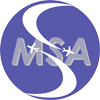First operational use of Mode S flight identity downlink

On 18 January, for the first time ever, radar identification of a flight was established and maintained without the assignment of a discrete secondary surveillance radar code. A Deutsche Lufthansa Boeing 737 flying between Frankfurt and Munich became the first aircraft to be identified by having its Mode S transponder-transmitted flight identity automatically correlated with flight plan data held by Air Traffic Control.
 The introduction of Mode S flight identity downlink into operational service provides a means to alleviate the shortage of secondary surveillance radar (SSR) codes. SSR was introduced to European airspace for widespread Air Traffic Management use during the 1960s and 70s. However SSR only provides 4096 codes in total which is insufficient to sustain the growth of air traffic given that already there are more aircraft in the air over Europe at any one time than the available codes that can be assigned for the complete duration of each flight.
Mode S radars are already operational providing surveillance data of high quality and high target capacity to meet the challenge of the continuing significant increase in air traffic, said John Law, Mode S Programme Manager at EUROCONTROL. What we saw on 18 January was a good test of the operational systems as the aircraft was a normal revenue flight and was fully compliant with European mandates for Mode S Surveillance.
The success of this first flight paves the way for expanded city-pair flights, based on Mode S flight identity, to be inaugurated by the Deutshe Flugsicherung (DFS), the German Air Navigation Service Provider, in the course of 2008. Flights managed together with neighbouring Mode S equipped air navigation service providers will follow shortly afterwards.
The introduction of Mode S flight identity downlink into operational service provides a means to alleviate the shortage of secondary surveillance radar (SSR) codes. SSR was introduced to European airspace for widespread Air Traffic Management use during the 1960s and 70s. However SSR only provides 4096 codes in total which is insufficient to sustain the growth of air traffic given that already there are more aircraft in the air over Europe at any one time than the available codes that can be assigned for the complete duration of each flight.
Mode S radars are already operational providing surveillance data of high quality and high target capacity to meet the challenge of the continuing significant increase in air traffic, said John Law, Mode S Programme Manager at EUROCONTROL. What we saw on 18 January was a good test of the operational systems as the aircraft was a normal revenue flight and was fully compliant with European mandates for Mode S Surveillance.
The success of this first flight paves the way for expanded city-pair flights, based on Mode S flight identity, to be inaugurated by the Deutshe Flugsicherung (DFS), the German Air Navigation Service Provider, in the course of 2008. Flights managed together with neighbouring Mode S equipped air navigation service providers will follow shortly afterwards.






.jpg)

.png)
Comments
There are no comments yet for this item
Join the discussion